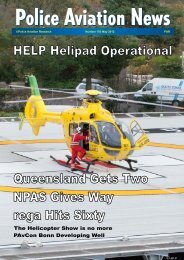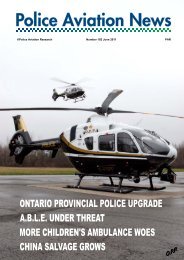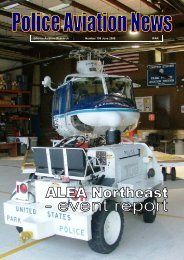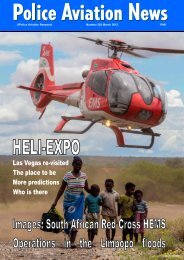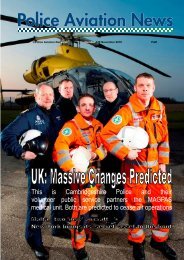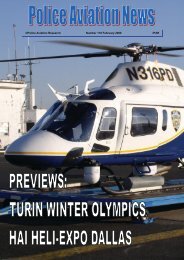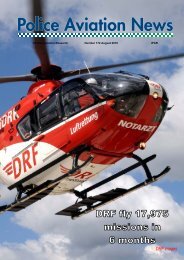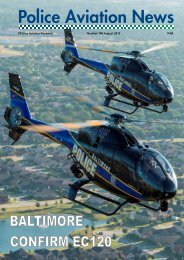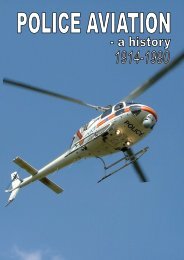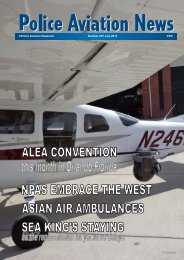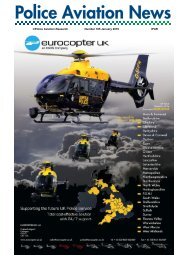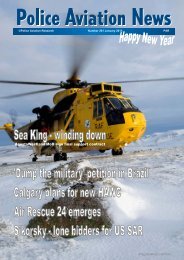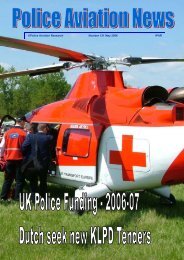Police Aviation News January 2011
Police Aviation News January 2011
Police Aviation News January 2011
You also want an ePaper? Increase the reach of your titles
YUMPU automatically turns print PDFs into web optimized ePapers that Google loves.
<strong>Police</strong> <strong>Aviation</strong> <strong>News</strong> <strong>January</strong> <strong>2011</strong> 29<br />
six passengers aboard feared dead, one body having been recovered immediately. The<br />
group was reportedly returning from a drug raid on the island of Vieques when they crashed<br />
north of the coastal city of Rio Grande. The National Guard crew were Col. Victor Torres<br />
Rodriguez, who was second in command of the Puerto Rico NG, pilots Hector Ramirez and<br />
Carlos Acevedo, and Sgt. Jose Omar Sostre. The prosecutors, Francisco Mujica de Leon<br />
and Mario Torres Marin, worked for the division of organised crimes, with the local justice<br />
department. The helicopter apparently changed route before the crash due to poor weather,<br />
the Associated Press reported. The officials had been in Vieques to help serve 43 arrest<br />
warrants after a seven-month investigation into drug dealers in Vieques. [Media]<br />
26 December 2010 Cessna 421C N31CU. Air ambulance of Cal-Ore Life Flight of Brookings,<br />
Oregon. During an interfacility flight originating in Crescent City, Calfornia en-route for<br />
Medford, Oregon in IFR weather with marginal VFR ceilings at both departure and destination,<br />
rain and forecast light to moderate icing. The flight in cruise at 11,000' encountered<br />
some ice, easily removed with the deice equipment. On descent into Medford ice accumulation<br />
increased, and when leveling off at approximately 8,000', the pilot experienced a vibration<br />
followed by the elevator control oscillations. Suspecting tail ice, the pilot continued to<br />
select the deice boots. Though he confirmed the wing boots were expanding and breaking<br />
off the ice, he did not get the cockpit annunciation indicating that the tail was being deiced.<br />
The pilot declared an emergency and asked for vectors direct to the airport. At a lower and<br />
warmer altitude icing dispersed and the elevator control smoothed out. The pilot made a<br />
normal "no-flap" landing. Maintenance determined that a faulty pressure air line in the deice<br />
boot caused the tail deice boots to not inflate properly. [Concern]<br />
27 December 2010 Eurocopter AS332L2 Super Puma B-HRN. Government Flying Services,<br />
Hong Kong. Helicopter deployed fighting fire close to a radar station was lifting water<br />
from the nearby Shing Mun Reservoir by Bambi bucket when one engine failed. Emergency<br />
floatation devices deployed and helicopter set down on the water and shut down upright.<br />
Crew reached land by swimming. Serious fresh water damage to lower parts of airframe<br />
and cabin, no injuries. [Media]<br />
FLIGHT SAFETY<br />
The US National Transportation Safety Board has highlighted that although government<br />
planes and helicopters are used every day to help protect public safety, as well as countless<br />
other tasks there is no-one looking after the safety of the flight crews, government employees<br />
and other passengers on those aircraft.<br />
The FAA says it doesn't have the authority to regulate the safety of aircraft operated by<br />
other federal agencies or state and local governments. And those government agencies,<br />
with the exception of the military, generally don't have the aviation expertise to do it themselves.<br />
That makes these aircraft — some government-owned, others leased — virtual safety<br />
"orphans," said NTSB Chairman Deborah Hersman. Someone, she said, needs to accept<br />
this duty.<br />
The issue came to light as the result of a two year investigation into a company that provided<br />
a helicopter to the US Forest Service for firefighting was responsible for a crash that<br />
killed nine people, including seven firefighters, and injured four others in a mountaintop<br />
clearing near Weaverville, California.<br />
The aircraft ought to have been equipped with sturdier fuel tanks less likely to rupture on<br />
impact, cabin seats that were crash-resistant and seatbelts with a less complicated release<br />
mechanism to reduce fatalities but the FAA certified the helicopter without inspecting it first.<br />
The FAA is responsible for the oversight of aircraft used solely to carry passengers but<br />
doesn't regulate aircraft engaged in government activities such as firefighting, border patrol,<br />
surveying or law enforcement.<br />
The issue is not new. A Senate investigation in 1991 criticized the lack of binding safety<br />
standards and recommended that Congress eliminate the exemption from FAA regulations<br />
for government aviation operations. [AP/Fosters]



